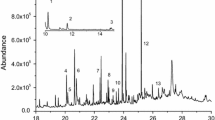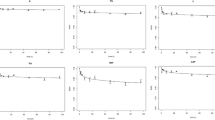Abstract
Purpose
Little information is currently available regarding the influence of different root exudate components (RECs) on the availability of persistent organic pollutants in the soil environment. In this study, we investigated the impacts of different RECs including organic acids, amino acids, and fructose on the availability of pyrene as a representative polycyclic aromatic hydrocarbon (PAH) in soils.
Materials and methods
Citric acid, oxalic acid, malic acid, serine, alanine, and fructose were used in the experiments as representative RECs. Pyrene-spiked soils (TypicPaleudalfs) with present RECs were incubated for 30 days, and the available fraction of pyrene was determined using n-butanol extraction procedure.
Results and discussion
The amount of n-butanol-extractable pyrene in soil increased with the addition of tested RECs and increased when REC concentrations are enhanced within the range of 0–21 g kg−1. The extractability of pyrene in soil with REC treatments and the enhancement ratio (r, %) of the extractable pyrene in soil by the addition of RECs after a 30-day incubation decreased in the following order: organic acids (oxalic acid ≥ citric acid > malic acid) > amino acid (alanine > serine) > fructose. This decrease was observed irrespective of soil sterilization, although the concentrations of extractable pyrene were lower in non-sterilized soils compared to sterilized soils. The concentrations of metal cations and dissolved organic matter (DOM) in solution increased when organic acids were added.
Conclusions
The tested RECs at concentrations of 0–21 g kg−1 clearly enhanced the availability of pyrene in soils, and larger amounts of RECs resulted in higher pyrene availabilities in the tested soils. Microbial biodegradation diminished the amount of available pyrene irrespective of the presence of RECs. The mechanism of REC-influenced availability of pyrene in soil may be related to the metal dissolution and release of DOM from soil solids. The results of this study will be useful in assessing PAH-related risks to human health and the environment and will be instructive in food safety and remediation strategies at contaminated sites.





Similar content being viewed by others
References
Alkorta I, Garbisu C (2001) Phytoremediation of organic contaminants in soils. Bioresour Technol 79:273–276
An CJ, Huang GH, Wei J, Yu H (2011) Effect of short-chain organic acids on the enhanced desorption of phenanthrene by rhamnolipid biosurfactant in soil–water environment. Water Res 45:5501–5510
Chiou CT, Peters LJ, Freed VH (1979) A physical concept of soil–water equilibria for nonionic organic compounds. Science 206:831–832
Chiou CT, McGroddy SE, Kile DE (1998) Partition characteristics of polycyclic aromatic hydrocarbons on soils and sediments. Environ Sci Technol 32:264–268
Christen K (1999) U.N. negotiations on POPs snag on malaria. Environ Sci Technol 33:444A–445A
Drever JI, Stillings LL (1997) The role of organic acids in mineral weathering. Colloids Surf 120:167–181
Folberth C, Scherb H, Suhadolc M, Munch JC, Schroll R (2009) In situ mass distribution quotient (iMDQ)—a new factor to compare bioavailability of chemicals in soils? Chemosphere 75:707–713
Fuhreman TM, Lichtensein EP (1978) Release of soil-bound methyl [14C] parathion residues and their uptake by earthworms and oatplants. J Agric Food Chem 26:605–611
Gao YZ, Shen Q, Ling WT, Ren LL (2008) Uptake of polycyclic aromatic hydrocarbons by Trifolium pretense L. from water in the presence of a nonionic surfactant. Chemosphere 72:636–643
Gao YZ, Ren LL, Ling WT, Gong SS, Sun BQ, Zhang Y (2010a) Desorption of phenanthrene and pyrene in soils by root exudates. Bioresour Technol 101:1159–1165
Gao YZ, Ren LL, Ling WT, Kang FX, Zhu XZ, Sun BQ (2010b) Effects of low-molecular-weight organic acids on sorption–desorption of phenanthrene in soils. Soil Sci Soc Am J 74:51–59
Gevao B, Mordaunt C, Semple KT, Piearce TG, Jones KC (2001) Bioavailability of nonextractable bound pesticide residues to earthworms. Environ Sci Technol 35:501–507
Gomez-Eyles JL, Collins CD, Hodson ME (2010) Relative proportions of polycyclic aromatic hydrocarbons differ between accumulation bioassays and chemical methods to predict bioavailability. Environ Pollut 158:278–284
Gomez-Eyles JL, Collins CD, Hodson ME (2011) Using deuterated PAH amendments to validate chemical extraction methods to predict PAH bioavailability in soils. Environ Pollut 159:918–923
Griffiths BS, Ritz K, Ebblewhite N, Dobson G (1999) Soil microbial community structure: effects of substrate loading rates. Soil Biol Biochem 31:145–153
Han AL, Yue L, Li Z, Wang HY, Wang Y, Ye QF, Lu L, Gan J (2009) Plant availability and phytotoxicity of soil bound residues of herbicide ZJ0273, a novel acetolactate synthase potential inhibitor. Chemosphere 77:955–961
Hatzinger PB, Alexander M (1995) Effect of aging of chemicals in soil on their biodegradability and extractability. Environ Sci Technol 29:537–545
Joner EJ, Corgié SC, Amellal N, Leyval C (2002) Nutritional constraints to degradation of polycyclic aromatic hydrocarbons in a simulated rhizosphere. Soil Biol Biochem 34:859–864
Kang FX, Chen DS, Gao YZ, Zhang Y (2010) Distribution of polycyclic aromatic hydrocarbons in subcellular root tissues of ryegrass (Lolium multiflorum Lam.). BMC Plant Biol 10:210
Kohl SD, Rice JA (1998) The binding of contaminants to humin: a mass balance. Chemosphere 36:251–261
Kong HL, Sun R, Gao YZ, Sun BQ (2013) Elution of polycyclic aromatic hydrocarbons in soil columns using low-molecular-weight organic acids. Soil Sci Soc Am J 77:72–82
Li H, Sheng G, Chiou CT, Xu O (2005) Relation of organic contaminant equilibrium sorption and kinetic uptake in plants. Environ Sci Technol 39:4864–4870
Ling WT, Ren LL, Gao YZ, Zhu XZ, Sun BQ (2009) Impact of low-molecular-weight organic acid on the availability of phenanthrene and pyrene in soil. Soil Biol Biochem 41:2187–2195
Ling WT, Zeng YC, Gao YZ, Dang HJ, Zhu XZ (2010) Availability of polycyclic aromatic hydrocarbons in aging soils. J Soils Sedim 10:799–807
Liste HH, Alexander M (2002) Butanol extraction to predict bioavailability of PAHs in soil. Chemosphere 46:1011–1017
Lu HL, Yan CL, Liu JC (2007) Low-molecular-weight organic acids exuded by mangrove (Kandelia candel (L.) Druce) roots and their effect on cadmium species change in the rhizosphere. Environ Exper Bot 61:159–166
Mckeague JA (1978) A manual of soil sampling and methods of analysis. Canadian Society of Soil Science, Ottawa
Miya K, Firestone MK (2001) Enhanced phenanthrene biodegradation in soils by slender oat root exudates and root debris. J Environ Qual 30:1911–1918
Monteriro RTR, Queiroz BPV, Cella AC (1999) Distribution of 14C-atrazine residues in humus fractions of a Brazilian soil. Chemosphere 39:293–301
Mott HV (2002) Association of hydrophobic organic contaminants with soluble organic matter: evaluation of the database of K doc values. Adv Environ Res 6:577–593
Nakamura M, Yamada S (1996) Conditions for solid-phase extraction of agricultural chemicals in waters by using n-octanol–water partition coefficients. Analyst 121:469–475
Ouvrard S, Lapole D, Morel JL (2006) Root exudates impact on phenanthrene availability. Water Air Soil Pollut Focus 6:343–352
Palomo M, Bhandari A (2006) Impact of aging on the formation of bound residues after peroxidase-mediated treatment of 2,4-DCP contaminated soils. Environ Sci Technol 40:3402–3408
Puglisi E, Cappa F, Fragoulis G, Trevisan M, Del Re AA (2007) Bioavailability and degradation of phenanthrene in compost amended soils. Chemosphere 67:548–556
Reid BJ, Jones KC, Semple KT (2000) Bioavailability of persistent organic pollutants in soils and sediments: a perspective on mechanisms, consequences and assessment. Environ Pollut 108:103–112
Sabaté J, Vinas M, Solanas AM (2006) Bioavailability assessment and environmental fate of polycyclic aromatic hydrocarbons in biostimulated creosote-contaminated soil. Chemosphere 63:1648–1659
Saison C, Perrin-Ganier C, Amellal S, Morel JL, Schiavon M (2004) Effect of metals on the adsorption and extractability of 14C-phenanthrene in soils. Chemosphere 55:477–485
Semple KT, Morriss AWJ, Paton GI (2003) Bioavailability of hydrophobic organic contaminants in soils: fundamental concepts and techniques for analysis. Eur J Soil Sci 54:809–818
Shan J, Wang T, Li CL, Klumpp E, Ji R (2010) Bioaccumulation and bound-residue formation of a branched 4-nonylphenol isomer in the geophagous earthworm Metaphire guillelmi in a rice paddy soil. Environ Sci Technol 44:4558–4563
Smalla K, Wieland G, Buchner A, Zock A, Parzy J, Kaiser S, Roskot N, Heuer H, Berg G (2001) Bulk and rhizosphere soil bacterial communities studied by denaturing gradient gel electrophoresis: plant-dependent enrichment and seasonal shits revealed. Appl Environ Microbiol 67:4742–4751
Sun HW, Yan QS (2008) Influence of pyrene combination state in soils on its treatment efficiency by Fenton oxidation. J Environ Manag 88:556–563
Sun TR, Cang L, Wang QY, Zhou DM (2010) Roles of abiotic losses, microbes, plant roots, and root exudates on phytoremediation of PAHs in a barren soil. J Hazard Mater 176:919–925
Sun BQ, Gao YZ, Liu J, Sun YD (2012) Impact of different root exudates constituents on the availability of phenanthrene in soil. Soil Sci Soc Am 76:2041–2050
Wania F, Mackay D (1996) Tracking the distribution of persistent organic pollutants. Environ Sci Technol 30:390A–396A
Weber WJJ, Kim SH, Johnson MD (2002) Distributed reactivity model for sorption by soils and sediments: 15 high-concentration co-contaminant effects on phenanthrene sorption and desorption. Environ Sci Technol 36:3625–3634
White JC, Mattina MI, Lee WY, Eitzer BD, Iannucci-Berger W (2003) Role of organic acids in enhancing the desorption and uptake of weathered p, p′-DDE by Cucurbita pepo. Environ Pollut 124:71–80
Yang Y, Ratté D, Smets BF, Pignatello JJ, Grasso D (2001) Mobilization of soil organic matter by complexing agents and implications for polycyclic aromatic hydrocarbon desorption. Chemosphere 43:1013–1021
Yaws CL (1999) Chemical properties handbook. McGraw-Hill, New York
Yoshitomi KJ, Shann JR (2001) Corn (Zea mays L.) root exudates and their impact on 14C-pyrene mineralization. Soil Biol Biochem 33:1769–1776
Zhao Q, Li PJ, Stagnitti F, Ye J, Dong DB, Zhang YQ, Li P (2009) Effects of aging and freeze-thawing on extractability of pyrene in soil. Chemosphere 74:447–452
Zhu YH, Zhang SZ, Huang HL, Wei B (2009) Effects of maize root exudates and organic acids on the desorption of phenanthrene from soils. J Environ Sci 21:920–926
Acknowledgments
This work was supported by the National Natural Science Foundation of China (21077056, 51278252, 41171380, and 41171193), the Fundamental Research Funds for the Central Universities of China (KYZ201109), and the Key Technology R&D Program of Jiangsu Province (BE2011780).
Author information
Authors and Affiliations
Corresponding author
Additional information
Responsible editor: Jean-Paul Schwitzguébel
Rights and permissions
About this article
Cite this article
Sun, B., Ling, W. & Wang, Y. Can root exudate components influence the availability of pyrene in soil?. J Soils Sediments 13, 1161–1169 (2013). https://doi.org/10.1007/s11368-013-0712-4
Received:
Accepted:
Published:
Issue Date:
DOI: https://doi.org/10.1007/s11368-013-0712-4




